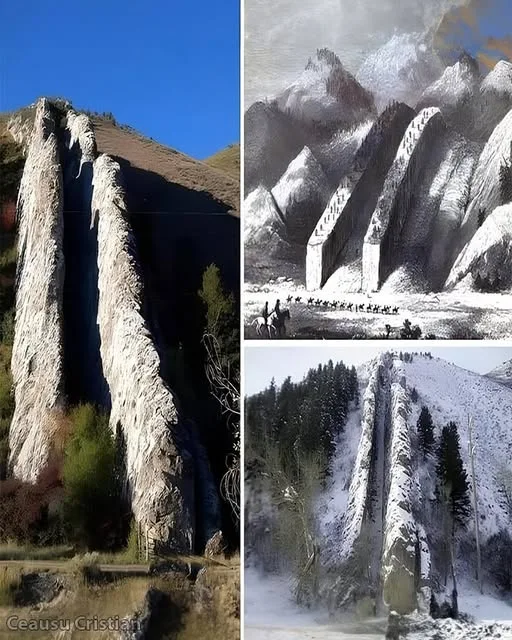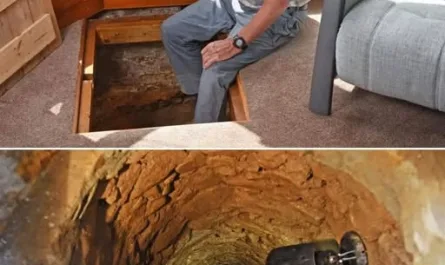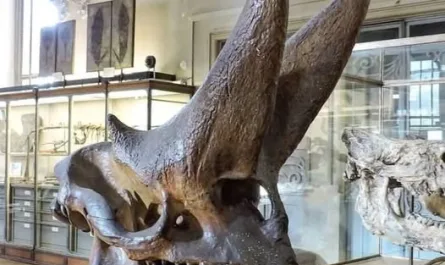Nestled near the border of Wyoming and Utah, the Devil’s Slide stands as a testament to the raw power and beauty of nature’s geological artistry. This captivating formation, located in Weber Canyon along the Weber River, has drawn the attention of travelers, geologists, and history enthusiasts alike for its striking appearance and the intriguing folklore that surrounds it. Whether you’re a nature lover, a history buff, or simply passing through, the Devil’s Slide is a must-see destination that offers a unique glimpse into the Earth’s dynamic past.

A Geological Wonder
The Devil’s Slide is a dramatic formation composed of two massive limestone slabs, each rising vertically from a steep hillside. Standing approximately 25 feet (7.6 meters) apart, these imposing slabs frame a narrow channel of softer rock, creating the illusion of a colossal stone chute or slide. The contrast between the towering, rugged limestone and the smooth, eroded channel is visually striking, making it one of the most photographed natural features in the region.
The formation owes its existence to millions of years of geological processes. The limestone slabs, part of the ancient sedimentary rock layers in the area, were formed from mineral deposits in a prehistoric sea that once covered this part of North America. Over time, tectonic forces uplifted the region, and erosion carved away the softer rock between the slabs, leaving behind the dramatic structure we see today. The softer rock in the channel, likely shale or a similar material, continues to erode, maintaining the slide-like appearance that gives the formation its name.
The Legend Behind the Name
The Devil’s Slide earned its evocative moniker from the railway builders who encountered it during the construction of the Union Pacific Railroad in the 1860s. As they worked through the rugged terrain of Weber Canyon, the workers were awestruck by the formation’s steep, narrow channel and its seemingly bottomless depth. In an era when superstition often mingled with hard labor, they speculated that the chute might plunge hundreds of feet beneath the surface—perhaps even leading straight to Hell itself. This blend of awe and imagination gave rise to the name “Devil’s Slide,” a title that has endured for over a century and a half.
The folklore surrounding the Devil’s Slide adds a layer of mystique to its natural beauty. While modern geology tells us the formation is a product of natural erosion and tectonic activity, the idea of a chute descending into the underworld captures the imagination. It’s easy to see why early workers, faced with the challenges of building a railroad through such rugged terrain, might have spun tales of otherworldly connections.
Visiting the Devil’s Slide
For those eager to witness the Devil’s Slide in person, the site is easily accessible and offers a rewarding experience. Located just off Interstate 84 in northern Utah, near the town of Morgan, the formation is visible from the highway, making it a convenient stop for road-trippers. A small pullout area allows visitors to park and take in the view, with interpretive signs providing information about the geology and history of the site.
For the best experience, consider bringing binoculars or a camera with a zoom lens to capture the details of the limestone slabs and the narrow channel. The surrounding Weber Canyon is also worth exploring, with its scenic beauty and opportunities for hiking, fishing, and wildlife viewing. The Weber River, which runs parallel to the formation, adds to the area’s charm, especially during the spring and summer when the water sparkles under the sun.
Why the Devil’s Slide Matters
The Devil’s Slide is more than just a geological curiosity; it’s a window into the Earth’s history and the human stories that have shaped the American West. Its formation tells a tale of ancient seas, tectonic upheaval, and the relentless work of erosion. At the same time, its name and the legends tied to it reflect the creativity and resilience of the people who built the infrastructure that connected the nation.
For geologists, the Devil’s Slide offers a clear example of differential erosion, where harder and softer rock types create dramatic contrasts in the landscape. For historians, it’s a reminder of the challenges faced by early railroad workers, whose efforts helped transform the United States into a connected, industrialized nation. And for visitors, it’s a chance to stand in awe of nature’s beauty and reflect on the stories that make places like this so special.
Planning Your Visit
If you’re planning a trip to the Devil’s Slide, here are a few tips to make the most of your experience:
-
Timing: The site is accessible year-round, but spring and fall offer mild weather and stunning views of the surrounding canyon. Summer can be hot, while winter may bring snow, so dress accordingly.
-
Photography: Early morning or late afternoon light casts beautiful shadows on the limestone slabs, making these ideal times for photography.
-
Nearby Attractions: Combine your visit with a stop at the nearby Thousand Mile Tree, a historic marker from the transcontinental railroad, or explore the trails and waterways of Weber Canyon.
-
Respect the Site: As with any natural landmark, leave no trace. Stick to designated viewing areas to preserve the fragile environment.
Final Thoughts
The Devil’s Slide is a remarkable blend of geological splendor and human history, offering something for everyone who visits. Whether you’re drawn by the science behind its formation, the eerie folklore of its name, or simply the chance to see a unique natural wonder, this site delivers an unforgettable experience. As you stand before the towering limestone slabs and gaze down the narrow chute, it’s easy to feel a connection to both the ancient forces that shaped the Earth and the people who gave this place its devilish name. So, the next time you’re traveling along the Wyoming-Utah border, make time to stop and explore the Devil’s Slide—a true gem of the American West.





